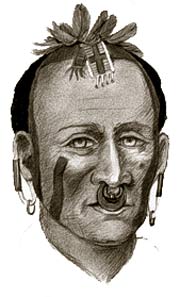Shawnee Indians
The Shawnee Indians were among the more feared and respected of Ohio's Indian nations. They were fierce warriors. The Shawnees spoke one of the languages of the Algonquian Indians, and so they are related to the Delaware Indians, the Miami Indians, and the Ottawa Indians. The Shawnees had a special friendship with the Wyandot Indians. The word Shawnee comes from the Algonquin word ‘shawun’ which means southerner. Other interpretations of the word suggest it might mean "those who have silver".

Shawnee camp recreated in the Fair at New Boston
The Shawnee Indians were living in the Ohio Valley as early as the late 1600s but the Iroquois Indians were unwilling to share these rich hunting grounds and drove the Shawnees out. Some went to Illinois, Pennsylvania, Maryland or Georgia. In time the Iroquois power weakened and the Shawnee Indians moved back into Ohio from the south and the east. They settled in the lower Scioto River valley.
Shawnee Indians always seemed to ally themselves with whoever could provide them with the most benefits. Up until the 1740s, the Shawnee Indians were allies of the French. In the 1740s British traders moved into Ohio and the Shawnee became allies with the British. The French then pushed the British out of Ohio, and the Shawnees then became allies of the French again. At the end of the French and Indian War when Britain defeated the French and took over the Ohio lands. With the defeat of the French, the French trading posts turned into British forts. Many of Ohio's native people realized their best interests were not the same as the white settlers moving into the area.
At this time many of Ohio's Indian nations, banded together, including the Shawnees, and continued fighting the British and their colonists. General Anthony Wayne defeated the Shawnees and other Ohio Indians at the Battle of Fallen Timbers in 1794. At this time, with no further options available to them, the Shawnees surrendered most of their lands in Ohio with the signing of the Treaty of Greeneville. Even though they signed the treaty, it wouldn't be until 1831 to 1833 that the United States would physically force the Shawnees to give up their land when Ohio sent the natives to reservations in Oklahoma and Kansas.
Notable Shawnee Leaders
Black Hoof (1731-1831) the Shawnee chief called Ca-ta-he-cassa, fought for 40 years to hold lands north of the Ohio River. But he reconciled to peaceful association with the Euro-Americans after he signed the Treaty of Greene Ville. Black Hoof, who at the time of his death was rumored to be 100 years old, died near Wapakoneta, Ohio.
Tecumseh (1768-1813) the Shawnee leader has been ranked with the greatest chiefs and hero-figures of American Indian history. Tecumseh was a warrior famous for his courage, intelligence, and character. But with his skills as an orator and leader, he labored to unite American Indian tribes into a strong confederation to prevent further division of tribal lands and to resist the advance of white settlements.
Blue Jacket (1745-1810) In 1774, Blue Jacket participated in Lord Dunmore's War, during which militiamen from Pennsylvania and Virginia tried to force the Ohio territory peoples to cede some of their lands. The British defeated the Shawnee in the Battle of Point Pleasant, but Blue Jacket emerged as a strong Shawnee leader.
Shawnee State Park
4404 State Route 125
Portsmouth, Ohio 45663-9003
Located in the Appalachian foothills near the banks of the Ohio River, Shawnee State Park is nestled in the 63,000-acre Shawnee State Forest.
Once the hunting grounds of the Shawnee Indians, the region is one of the most picturesque in the state, featuring erosion-carved valleys and wooded hills. The rugged beauty of the area has earned it the nickname "The Little Smokies." Shawnee State Forest has regained much of its original appearance from the days that Shawnee Native Americans used it for hunting. Conservation programs coupled with wise land use practices at Shawnee State Park have assured that this 1,168-acre recreational facility will continue to maintain its natural beauty.



